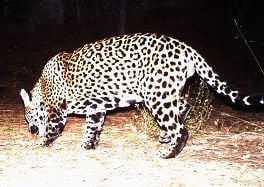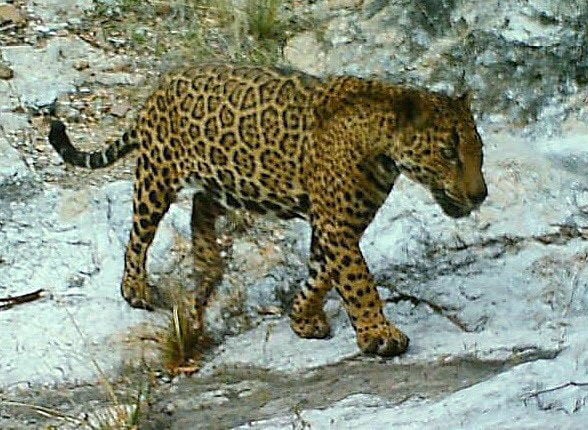Don’t get too excited by the new jaguar.
He’s just a stray cat, wandering the northern limits of his species’ range. He’s just a curiosity in today’s Arizona, insignificant in the greater scheme.
That’s the message from officialdom now that we know there is another new male jaguar roaming the Arizona borderlands.
In the Arizona Game and Fish Department’s official statement on the confirmation of a new roaring cat, Jim deVos, the assistant director for wildlife management, put the department’s position this way:
“Jaguars are a unique component of this state’s wildlife diversity and it is exciting to document a new visitor. However, in the absence of female jaguars and with the irregularity with which we document any jaguar presence in Arizona, this sighting in early December is important, but not an indicator of an establishing population in the state.”
This and other comments deVos and another Game and Fish official made Thursday are both correct in their particulars and diversionary in their spirit.
To say the new jaguar is a “visitor” suggests they aren’t really supposed to be here. But historical records show that’s clearly wrong. Before white settlement, jaguars lived at least as far north as the Grand Canyon and were permanent, reproducing residents of Arizona. In fact, their range stretched from California to Louisiana. Over the last 20 years, at least five males have crossed into Southern Arizona, at times apparently overlapping in their time here.
A hunter shot the last female known to have lived in the state in 1963, near Big Lake in the White Mountains. My colleague Tony Davis interviewed that hunter, Terry Penrod, about four years ago at his Lakeside home. In that case, the Game and Fish Department recently concluded the female was planted by a hunting guide, even though the accused guide denied it.
In other words, this is a pattern. Political pressures mean Game and Fish must both celebrate the existence of the jaguar in Arizona and deny that it really belongs.
What pressures? If you acknowledge that jaguars belong here, then that begs the question, “What are you going to do about them?” It’s not just an abstract question: The fact that jaguars are listed as an endangered species demands that we answer it. And the proposal to build a big new wall along the border makes the issue urgent.
After a lawsuit by the Tucson-based Center for Biological Diversity, the U.S. Fish and Wildlife Service answered that demand in 2014 by designating 858,137 acres of Southern Arizona and southwestern New Mexico as critical habitat for the jaguar.
Leading up to that designation was a raft of research and a torrent of public comments. Among the most intriguing studies, a piece called a Population Viability Analysis for the Jaguar in the Northwestern Range. Philip Miller of the Conservation Breeding Specialist Group conducted the study, which attempted to do what the title says — figure out how many jaguars could potentially live in the area from Jalisco in western Mexico, north along the Sierra Madre all the way to Arizona.
Under different assumptions about the habitat, Miller concluded that the carrying capacity in Southern Arizona is between five and 31 adult jaguars. At best there will be 2-4 females, he concludes. The study finds there’s a 14-24 percent chance a reproducing population will become established in the most optimistic scenario. More likely, there will continue to be a series of wandering males in the borderlands of northern Sonora and Southern Arizona.
“The probability of having a population established there? It’s a tenuous future at best for the species in Southern Arizona,” Miller told me Thursday.
Partly for that reason, Arizona Game and Fish opposed the designation of critical habitat by the Fish and Wildlife Service. This area is not “essential” for the recovery of the species, as required by the Endangered Species Act, Game and Fish argues. That essential habitat is all further south in Mexico, Central America and South America.
They’re right about this fundamental — if there were no jaguars in Arizona, it would not make a difference as to the survival of the species as a whole.
But their conclusion also helps them avoid another fundamental challenge, even more important with the election of Donald Trump as president. The border fence already is something of an obstacle to wildlife in the areas where it exists. Any significant expansion would block animals’ movements even more.
But deVos and Game and Fish colleague Jamey Driscoll argued in a Facebook Live video Thursday that the continual arrival of new jaguars, apparently from the mountains of eastern Sonora 130 miles south, shows the border fence isn’t such an obstacle.
“The fact that this jaguar wandered from there demonstrates there is still biological connectivity through the borderlands,” deVos said.
Driscoll added, “Some of the recent efforts to put up barriers between Mexico and the U.S. at the border aren’t affecting wildlife populations crossing back and forth between the two countries.”
But the fact that some jaguars are making it through doesn’t show that. It could be that border walls have deterred other jaguars already, and the addition of more walls in important areas could block them completely.
Dismissing the significance of these and other jaguars allows us to avoid dealing with the effects of the border wall and other policy decisions on animals that have shown over centuries they belong here.





